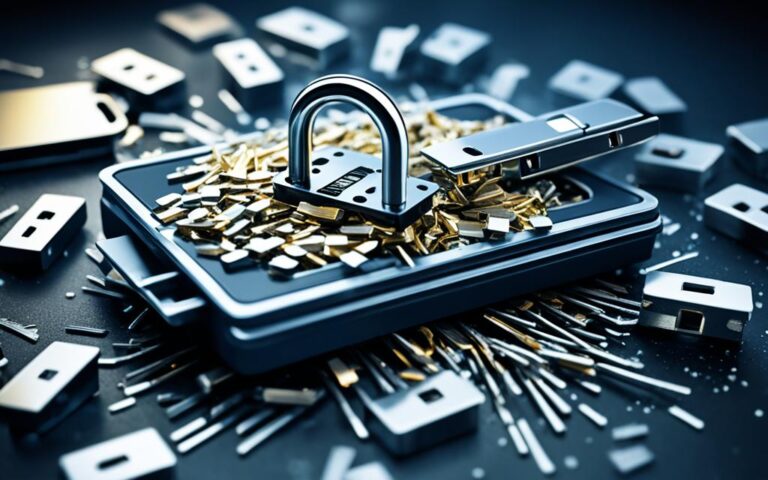The Importance of Data Destruction in the Retail Industry
In today’s digital age, the retail industry relies heavily on technology for various aspects of its operations. From managing inventory and processing transactions to analyzing customer data, the retail sector generates a vast amount of digital information. However, with the increasing threat of data breaches and cyber attacks, ensuring retail industry data security has become more critical than ever.
Data destruction plays a crucial role in protecting sensitive information and maintaining the trust of customers. Simply restoring devices to factory settings is not enough to permanently delete data, leaving businesses vulnerable to data theft. Improper disposal or recycling of electronics can have severe consequences and put sensitive information at risk.
That is why understanding the importance of data destruction is paramount for the retail industry. Effective data destruction practices not only help businesses comply with privacy legislation such as GDPR but also safeguard valuable customer data and mitigate the risk of reputational damage. By securely and permanently erasing data, retailers can ensure that confidential information remains confidential and instill confidence in their customers.
Why Professional Data Destruction is Necessary
In today’s digital age, the volume of data generated and stored by businesses is staggering. From customer information to financial records, sensitive data is a valuable asset that requires careful protection. However, simply restoring devices to factory settings or using software to wipe data is not sufficient to guarantee its permanent deletion. This is where professional data destruction services come into play.
Professional data destruction techniques, such as degaussing, physical destruction, and overwriting, offer a higher level of security and ensure that data is destroyed beyond recovery. These methods provide businesses with the peace of mind that their confidential information cannot be accessed or misused.
Data destruction is not only crucial for avoiding data theft but also maintaining legal compliance. With the implementation of privacy laws like the General Data Protection Regulation (GDPR), businesses are obligated to protect the personal information of their customers. Failure to comply with these regulations can result in severe penalties, including fines and reputational damage.
The Necessity of Data Destruction Techniques
Data destruction is necessary for several reasons:
- To prevent data theft and protect sensitive information
- To maintain legal compliance with privacy regulations
- To build trust with customers
- To free up valuable office space
- To uphold business reputation
By implementing professional data destruction measures, businesses can effectively prevent data breaches and minimize the risk of fines and legal repercussions. Moreover, it showcases a commitment to data protection, which can enhance the reputation of the business among customers, partners, and stakeholders.
To better understand the necessity of professional data destruction, let’s take a closer look at some of the techniques commonly used:
| Data Destruction Technique | Description |
|---|---|
| Degaussing | A method that uses powerful magnets to disrupt the magnetic fields in data storage devices, rendering the data irretrievable. |
| Physical Destruction | This technique involves physically destroying the storage device to prevent any possibility of reconstruction, such as incineration, crushing, or shredding. |
| Overwriting | By overwriting existing data with new data using specialized software, overwriting ensures that the original data is erased beyond recovery. |
Each technique has its advantages and suitability depending on the type of data storage device and the desired reusability. For example, degaussing is commonly used for magnetic storage media like hard drives, while physical destruction may be necessary for high-security environments.
“Professional data destruction techniques offer a higher level of security and ensure that data is destroyed beyond recovery.”
It is important for businesses to prioritize data destruction as part of their cybersecurity strategy. By doing so, they can protect sensitive information, maintain legal compliance, build trust with customers, and uphold their business reputation. Relying on professional data destruction services helps businesses demonstrate their commitment to data protection and safeguard themselves from the detrimental consequences of data breaches.
Data Destruction Techniques
When it comes to securely disposing of data, there are three main techniques: degaussing, physical destruction, and overwriting. Each technique serves the purpose of ensuring that data is permanently destroyed and irretrievable.
Degaussing: This technique involves using powerful magnets to disrupt the magnetic fields in data storage devices such as hard drives and tape media. By doing so, it renders the data unreadable and effectively destroys the information stored within. This method is particularly effective for devices that rely on magnetic storage.
Physical Destruction: Physical destruction entails physically destroying the storage device in a manner that prevents any possibility of reconstruction. This can be achieved through methods such as incineration, crushing, or shredding. By rendering the device unusable and irreparable, any data stored on it becomes permanently inaccessible.
Overwriting: Overwriting involves erasing existing data by overwriting it with new data using specialized software. The process ensures that the original data is overwritten with random patterns, making it virtually impossible to recover. This technique is commonly used for securely disposing of data on hard drives and solid-state drives.
Each data destruction technique has its own advantages and suitability depending on the type of data storage device and the desired reusability. For instance, degaussing is ideal for magnetic storage media, physical destruction is suitable for devices that cannot be reused, while overwriting is a more versatile method applicable to various types of storage devices.
| Technique | Advantages | Suitability |
|---|---|---|
| Degaussing | – Irreversible destruction of magnetic data – Suitable for magnetic storage media |
– Hard drives – Tape media |
| Physical Destruction | – Ensures complete device destruction – Prevents reconstruction |
– Devices that cannot be reused |
| Overwriting | – Versatile method for various storage devices – Permanent data erasure |
– Hard drives – Solid-state drives |
Choosing the appropriate data destruction technique depends on factors such as the type of storage device, desired reusability, and level of security needed.
The Importance of Data Destruction for Cybersecurity
Data destruction plays a crucial role in cybersecurity by preventing data theft and protecting sensitive information from falling into the wrong hands. Inadequate data destruction protocols can lead to compromised online systems, identity theft, unauthorized access, and reputational damage. Proper data destruction ensures that no one has access to sensitive information and controls the flow of information within the organization.
Cybersecurity is a top concern for businesses in today’s digital age, with data breaches and cyber-attacks becoming increasingly prevalent. Without proper data destruction measures in place, businesses are at risk of exposing valuable data to malicious actors. This can result in financial loss, legal implications, and damage to the company’s reputation.
“Data destruction is not just a compliance requirement; it is an essential part of an organization’s overall cybersecurity strategy. It helps prevent data theft, minimize the risk of unauthorized access, and safeguard sensitive information from falling into the wrong hands.”
Implementing robust data destruction practices ensures that data is permanently destroyed and irretrievable, minimizing the risk of data theft. By securely disposing of outdated or redundant data storage devices, businesses can ensure that sensitive information cannot be recovered, even by skilled hackers or data recovery specialists.
The Consequences of Inadequate Data Destruction
- Compromised online systems: Incomplete data destruction leaves vulnerabilities in digital systems, making them susceptible to cyber-attacks and unauthorized access.
- Identity theft: Improperly disposed of personal or financial data can be used for identity theft, leading to financial ruin for individuals and legal consequences for businesses.
- Unauthorized access: Neglecting to destroy data properly can result in unauthorized individuals gaining access to sensitive information, potentially leading to further security breaches and data misuse.
- Reputational damage: Data breaches erode customer trust and confidence in a business, resulting in reputational damage that can be challenging to recover from.
By incorporating secure data destruction practices into their cybersecurity protocols, businesses can effectively protect themselves and their customers from data breaches and other security risks. This includes partnering with professional data destruction services that use advanced techniques such as degaussing, physical destruction, and overwriting to ensure complete data eradication.
Proper data destruction not only helps businesses comply with data protection regulations but also reduces the risk of financial loss or business failure due to data breaches. It demonstrates a commitment to data protection and instills confidence in customers, employees, and stakeholders regarding the security of their information.
As cyber threats continue to evolve, businesses must prioritize data protection and implement robust data destruction practices. By doing so, they can mitigate the risk of data breaches, safeguard sensitive information, and maintain the trust and confidence of their customers.
Compliance and Data Destruction
Data destruction is an essential aspect of maintaining compliance with privacy laws and regulations within the retail industry. To ensure the protection of clients’ personal information, businesses across many countries, including the United Kingdom, are required by law to implement robust data destruction practices. Alongside legal requirements, proper data destruction demonstrates a commitment to compliance and reduces the risk of legal exposure.
Failure to comply with data destruction regulations can lead to punitive measures from regulatory bodies, costly lawsuits, and severe damage to a business’s reputation. Therefore, organizations must prioritize data destruction as an integral part of their compliance programs, aiming to safeguard sensitive information and prevent potential data breaches. By implementing effective data destruction practices, companies can mitigate the risks associated with non-compliance and safeguard their reputation.
Benefits of Data Destruction for Businesses
Data destruction offers several benefits for businesses. It helps save on data storage costs by reducing the need for expensive infrastructure and management. By securely disposing of unnecessary data, businesses can free up valuable storage space and optimize their data management processes, resulting in significant cost savings.
Another crucial benefit of data destruction is the prevention of data theft. By effectively destroying sensitive data, businesses can safeguard against identity theft and other fraudulent activities. This not only protects the business’s financial assets but also enhances customer trust and brand reputation.
Data destruction also plays a vital role in controlling the flow of information within the organization. By ensuring that only authorized individuals have access to sensitive data, businesses can mitigate the risk of unauthorized data access or leakage. This helps maintain data security and prevents potential data breaches, which can have severe legal and financial implications.
In an increasingly competitive landscape, data destruction can also give businesses a competitive edge. By prioritizing data security measures, businesses can demonstrate their commitment to protecting sensitive information, thereby building trust with customers and partners. This can set them apart from competitors and attract customers who prioritize data privacy and security.
Furthermore, data destruction supports compliance efforts, ensuring that businesses adhere to data protection regulations and avoid costly penalties. Properly destroying data in accordance with legal requirements helps businesses maintain compliance with privacy laws such as GDPR, reinforcing their commitment to data security and reducing the risk of legal repercussions.
Overall, data destruction provides numerous benefits for businesses, including cost savings, data theft prevention, enhanced data security measures, competitive advantage, and compliance support. By implementing effective data destruction strategies, businesses can safeguard sensitive information, protect their reputation, and stay ahead in today’s data-driven world.
Data Destruction Best Practices for Businesses
When it comes to data destruction, businesses must prioritize secure disposal and responsible e-waste recycling. Following best practices in this area is essential to protect sensitive information and ensure compliance with data protection regulations. Partnering with professional data destruction services is crucial to guarantee the complete destruction of data, providing peace of mind for businesses and their customers.
Secure Disposal:
Secure disposal involves physically destroying all information on disks and ensuring proper disposal. This step is essential to prevent potential threats and avoid future data breaches. By partnering with trusted e-waste disposal providers like Namo e-Waste, businesses can ensure that their sensitive data is handled responsibly and securely.
E-Waste Recycling:
Responsible e-waste recycling is another crucial aspect of data destruction best practices. It is important for organizations to choose reliable and compliant recycling options that align with GDPR-compliant security measures. By recycling electronic devices in an environmentally friendly manner, businesses can mitigate their impact on the planet and contribute to a sustainable future.
| Data Destruction Best Practices | Benefits |
|---|---|
| Partner with professional data destruction services | Guarantees the complete destruction of data |
| Secure disposal | Prevents potential threats and data breaches |
| E-Waste recycling | Contributes to a sustainable future |
By adhering to these data destruction best practices, businesses can protect their sensitive information, maintain compliance, and uphold their reputation. It is essential to prioritize secure disposal and responsible e-waste recycling to mitigate the risks associated with data breaches and environmental harm.
Conclusion
In conclusion, data destruction plays a crucial role in the retail industry to safeguard sensitive information, maintain compliance with privacy regulations, build trust with customers, and protect business reputation. The importance of data security cannot be overstated, as businesses face the constant threat of data theft and the associated financial and legal repercussions.
By utilizing professional data destruction techniques, businesses can ensure that data is permanently destroyed and irretrievable, mitigating the risk of data breaches and unauthorized access. Data destruction is an integral part of effective data management strategies, allowing businesses to save costs, free up valuable storage space, and maintain a competitive edge in the market.
To ensure the secure and responsible disposal of data, it is essential for businesses to follow best practices and collaborate with trusted e-waste disposal services. By doing so, they can demonstrate a firm commitment to data protection, while also fulfilling their legal and regulatory obligations. Safeguarding sensitive information is not just a legal requirement, but also a vital ethical responsibility in today’s digital age.
FAQ
What is the importance of data destruction in the retail industry?
Data destruction in the retail industry is crucial for safeguarding sensitive information, maintaining compliance with privacy regulations, building trust with customers, and protecting business reputation.
Why is professional data destruction necessary?
Professional data destruction techniques ensure that data is permanently destroyed, preventing data theft and reducing the risk of financial and legal repercussions.
What are the different data destruction techniques?
The three main data destruction techniques are degaussing, physical destruction, and overwriting.
How does data destruction contribute to cybersecurity?
Data destruction plays a crucial role in cybersecurity by preventing data theft and protecting sensitive information from falling into the wrong hands.
What is the link between data destruction and compliance?
Data destruction is essential for maintaining compliance with privacy laws and regulations, demonstrating a commitment to compliance, and reducing legal exposure.
What are the benefits of data destruction for businesses?
Data destruction helps save on data storage costs, prevents data theft, controls the flow of information, enhances data security measures, and protects business reputation.
What are the best practices for data destruction?
Best practices for data destruction include partnering with professional data destruction services, choosing reliable and compliant recycling options, and ensuring secure disposal and responsible e-waste recycling.













